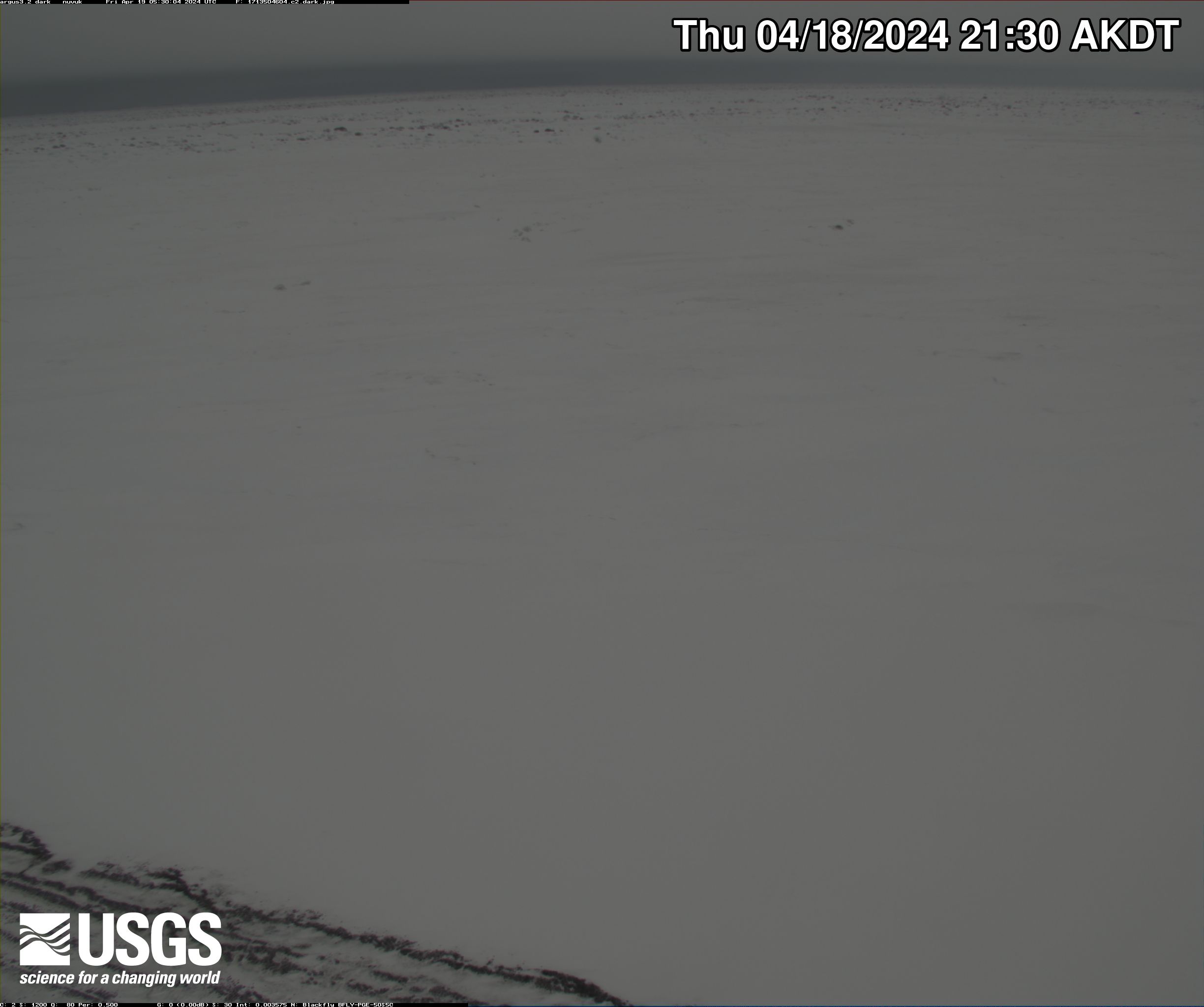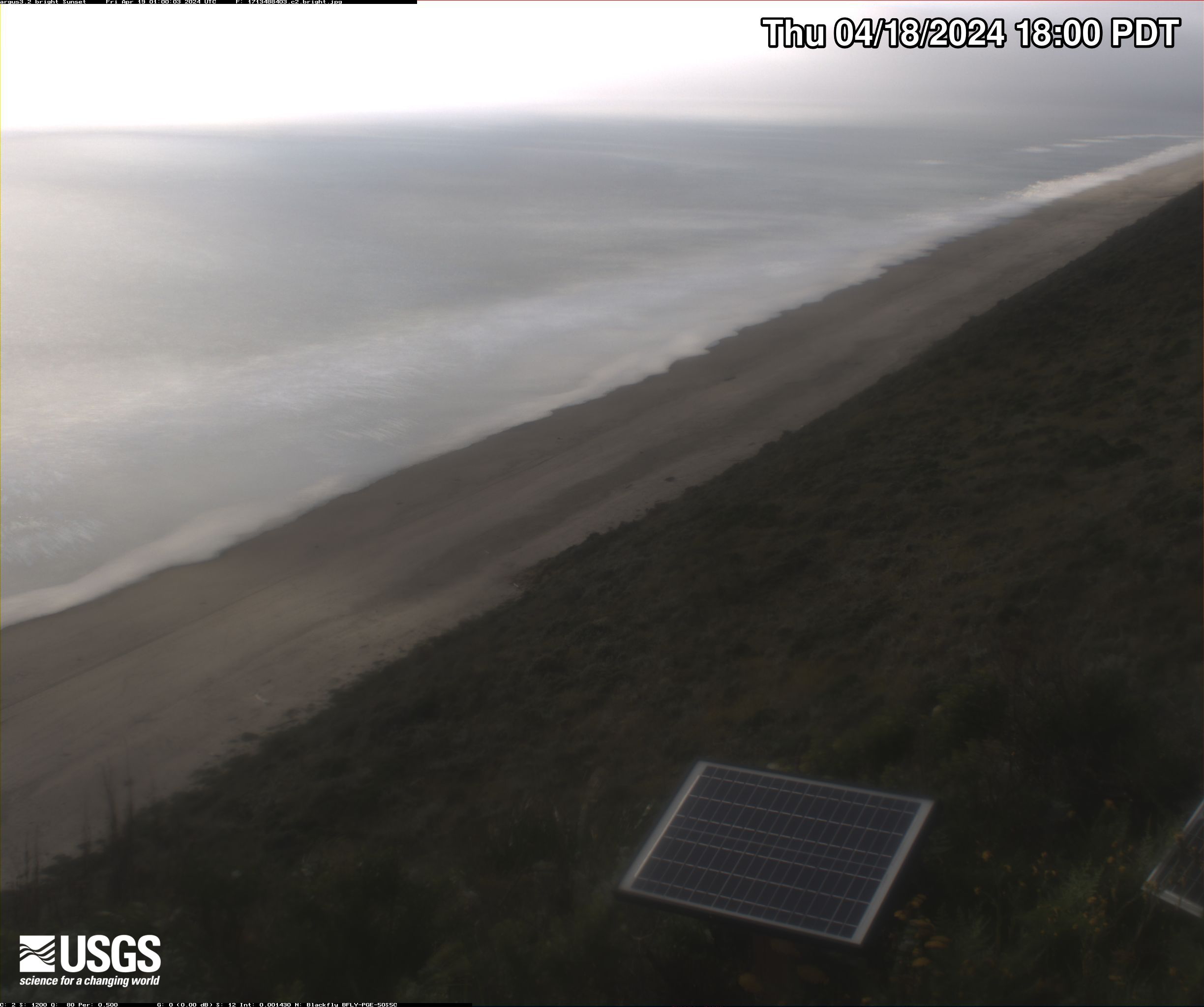Two video cameras are installed atop a utility pole near the northernmost point of land in the United States at Nuvuk (Point Barrow), Alaska. The cameras point northwest toward the Arctic Ocean and the boundary between the Chukchi and Beaufort Seas. Every half hour during daylight hours, the cameras collect snapshots and video for 10 minutes.
Webcams
Webcams
Two video cameras are installed atop a utility pole near the northernmost point of land in the United States at Nuvuk (Point Barrow), Alaska. The cameras point northwest toward the Arctic Ocean and the boundary between the Chukchi and Beaufort Seas. Every half hour during daylight hours, the cameras collect snapshots and video for 10 minutes.
Two video cameras are installed atop a utility pole near the northernmost point of land in the United States at Nuvuk (Point Barrow), Alaska. The cameras point northwest toward the Arctic Ocean and the boundary between the Chukchi and Beaufort Seas. Every half hour during daylight hours, the cameras collect snapshots and video for 10 minutes.
Two video cameras are installed atop a utility pole near the northernmost point of land in the United States at Nuvuk (Point Barrow), Alaska. The cameras point northwest toward the Arctic Ocean and the boundary between the Chukchi and Beaufort Seas. Every half hour during daylight hours, the cameras collect snapshots and video for 10 minutes.
Two video cameras are installed atop a utility pole near the northernmost point of land in the United States at Nuvuk (Point Barrow), Alaska. The cameras point northwest toward the Arctic Ocean and the boundary between the Chukchi and Beaufort Seas. Every half hour during daylight hours, the cameras collect snapshots and video for 10 minutes.
Two video cameras are installed atop a utility pole near the northernmost point of land in the United States at Nuvuk (Point Barrow), Alaska. The cameras point northwest toward the Arctic Ocean and the boundary between the Chukchi and Beaufort Seas. Every half hour during daylight hours, the cameras collect snapshots and video for 10 minutes.
Two video cameras are installed atop a utility pole near the northernmost point of land in the United States at Nuvuk (Point Barrow), Alaska. The cameras point northwest toward the Arctic Ocean and the boundary between the Chukchi and Beaufort Seas. Every half hour during daylight hours, the cameras collect snapshots and video for 10 minutes.
Two video cameras are installed atop a utility pole near the northernmost point of land in the United States at Nuvuk (Point Barrow), Alaska. The cameras point northwest toward the Arctic Ocean and the boundary between the Chukchi and Beaufort Seas. Every half hour during daylight hours, the cameras collect snapshots and video for 10 minutes.
Two video cameras are installed atop a utility pole near the northernmost point of land in the United States at Nuvuk (Point Barrow), Alaska. The cameras point northwest toward the Arctic Ocean and the boundary between the Chukchi and Beaufort Seas. Every half hour during daylight hours, the cameras collect snapshots and video for 10 minutes.
Two video cameras are installed atop a utility pole near the northernmost point of land in the United States at Nuvuk (Point Barrow), Alaska. The cameras point northwest toward the Arctic Ocean and the boundary between the Chukchi and Beaufort Seas. Every half hour during daylight hours, the cameras collect snapshots and video for 10 minutes.
Two video cameras are installed atop a utility pole near the northernmost point of land in the United States at Nuvuk (Point Barrow), Alaska. The cameras point northwest toward the Arctic Ocean and the boundary between the Chukchi and Beaufort Seas. Every half hour during daylight hours, the cameras collect snapshots and video for 10 minutes.
Two video cameras are installed atop a utility pole near the northernmost point of land in the United States at Nuvuk (Point Barrow), Alaska. The cameras point northwest toward the Arctic Ocean and the boundary between the Chukchi and Beaufort Seas. Every half hour during daylight hours, the cameras collect snapshots and video for 10 minutes.
Two video cameras are installed atop a utility pole near the northernmost point of land in the United States at Nuvuk (Point Barrow), Alaska. The cameras point northwest toward the Arctic Ocean and the boundary between the Chukchi and Beaufort Seas. Every half hour during daylight hours, the cameras collect snapshots and video for 10 minutes.
Two video cameras are installed atop a utility pole near the northernmost point of land in the United States at Nuvuk (Point Barrow), Alaska. The cameras point northwest toward the Arctic Ocean and the boundary between the Chukchi and Beaufort Seas. Every half hour during daylight hours, the cameras collect snapshots and video for 10 minutes.
Two video cameras are installed atop a utility pole near the northernmost point of land in the United States at Nuvuk (Point Barrow), Alaska. The cameras point northwest toward the Arctic Ocean and the boundary between the Chukchi and Beaufort Seas. Every half hour during daylight hours, the cameras collect snapshots and video for 10 minutes.
Two video cameras are installed atop a utility pole near the northernmost point of land in the United States at Nuvuk (Point Barrow), Alaska. The cameras point northwest toward the Arctic Ocean and the boundary between the Chukchi and Beaufort Seas. Every half hour during daylight hours, the cameras collect snapshots and video for 10 minutes.
Two video cameras are installed atop a utility pole near the northernmost point of land in the United States at Nuvuk (Point Barrow), Alaska. The cameras point northwest toward the Arctic Ocean and the boundary between the Chukchi and Beaufort Seas. Every half hour during daylight hours, the cameras collect snapshots and video for 10 minutes.
Two video cameras are installed atop a utility pole near the northernmost point of land in the United States at Nuvuk (Point Barrow), Alaska. The cameras point northwest toward the Arctic Ocean and the boundary between the Chukchi and Beaufort Seas. Every half hour during daylight hours, the cameras collect snapshots and video for 10 minutes.
Two video cameras are installed atop a utility pole near the northernmost point of land in the United States at Nuvuk (Point Barrow), Alaska. The cameras point northwest toward the Arctic Ocean and the boundary between the Chukchi and Beaufort Seas. Every half hour during daylight hours, the cameras collect snapshots and video for 10 minutes.
Two video cameras are installed atop a utility pole near the northernmost point of land in the United States at Nuvuk (Point Barrow), Alaska. The cameras point northwest toward the Arctic Ocean and the boundary between the Chukchi and Beaufort Seas. Every half hour during daylight hours, the cameras collect snapshots and video for 10 minutes.
Video camera bright image at Sunset State Beach in Watsonville, California, looking north. Learn more about the cameras and their imagery, and how we're using them to study coastal change.
Video camera bright image at Sunset State Beach in Watsonville, California, looking north. Learn more about the cameras and their imagery, and how we're using them to study coastal change.
Video camera bright image at Sunset State Beach in Watsonville, California, looking north. Learn more about the cameras and their imagery, and how we're using them to study coastal change.
Video camera bright image at Sunset State Beach in Watsonville, California, looking north. Learn more about the cameras and their imagery, and how we're using them to study coastal change.
Video camera snapshot at Sunset State Beach in Watsonville, California, looking northwest. Learn more about the cameras and their imagery, and how we're using them to study coastal change.
Video camera snapshot at Sunset State Beach in Watsonville, California, looking northwest. Learn more about the cameras and their imagery, and how we're using them to study coastal change.
Video camera dark image at Sunset State Beach in Watsonville, California, looking northwest. Learn more about the cameras and their imagery, and how we're using them to study coastal change.
Video camera dark image at Sunset State Beach in Watsonville, California, looking northwest. Learn more about the cameras and their imagery, and how we're using them to study coastal change.
Video camera snapshot at Sunset State Beach in Watsonville, California, looking northwest. Learn more about the cameras and how we're using them to study coastal change.
Video camera snapshot at Sunset State Beach in Watsonville, California, looking northwest. Learn more about the cameras and how we're using them to study coastal change.
Video camera snapshot at Sunset State Beach in Watsonville, California, looking north. Learn more about the cameras and how we're using them to study coastal change.
Video camera snapshot at Sunset State Beach in Watsonville, California, looking north. Learn more about the cameras and how we're using them to study coastal change.
Video camera variance image at Sunset State Beach in Watsonville, California, looking northwest. Learn more about the cameras and their imagery, and how we're using them to study coastal change.
View a larger version
Video camera variance image at Sunset State Beach in Watsonville, California, looking northwest. Learn more about the cameras and their imagery, and how we're using them to study coastal change.
View a larger version
Video camera variance image at Sunset State Beach in Watsonville, California, looking north. Learn more about the cameras and their imagery, and how we're using them to study coastal change.
Video camera variance image at Sunset State Beach in Watsonville, California, looking north. Learn more about the cameras and their imagery, and how we're using them to study coastal change.
Video camera timex (time-exposure) image at Sunset State Beach in Watsonville, California, looking northwest. Learn more about the cameras and how we're using them to study coastal change.
Video camera timex (time-exposure) image at Sunset State Beach in Watsonville, California, looking northwest. Learn more about the cameras and how we're using them to study coastal change.
Video camera timex (time-exposure) image at Sunset State Beach in Watsonville, California, looking north. Learn more about the cameras and how we're using them to study coastal change.
Video camera timex (time-exposure) image at Sunset State Beach in Watsonville, California, looking north. Learn more about the cameras and how we're using them to study coastal change.

Tres Palmas Video Camera Mid-Field Bright Image, 2
Tres Palmas Video Camera Mid-Field Bright Image, 2Video camera bright image at Tres Palmas in Rincón, on the west coast of Puerto Rico. [Larger version]
Learn more about the cameras and how we're using them to study wave dynamics.
Tres Palmas Video Camera Mid-Field Bright Image, 2
Tres Palmas Video Camera Mid-Field Bright Image, 2Video camera bright image at Tres Palmas in Rincón, on the west coast of Puerto Rico. [Larger version]
Learn more about the cameras and how we're using them to study wave dynamics.





















